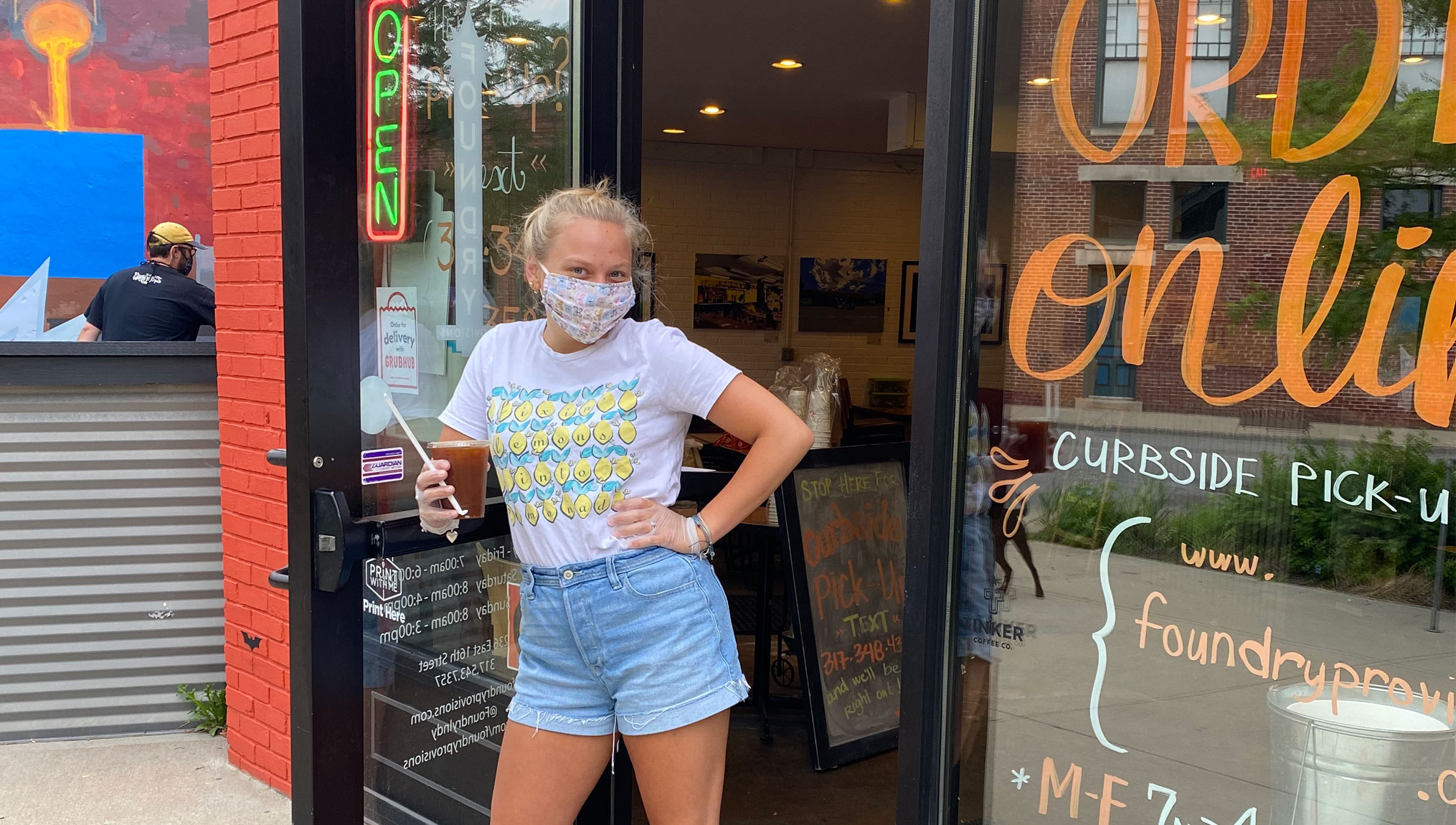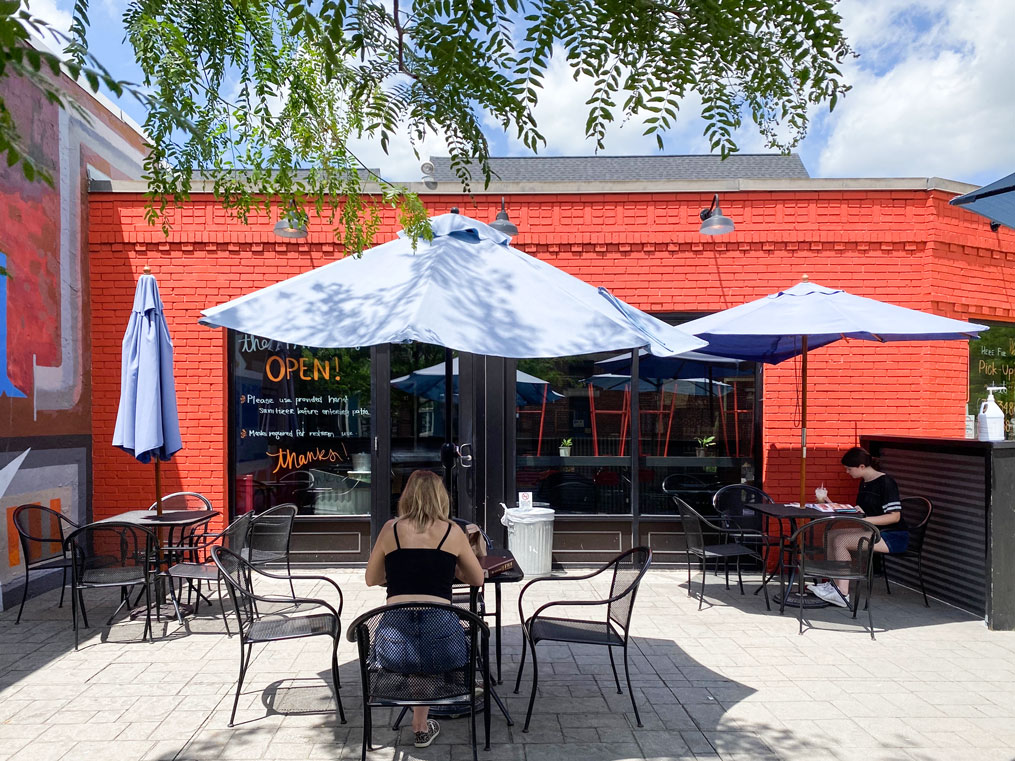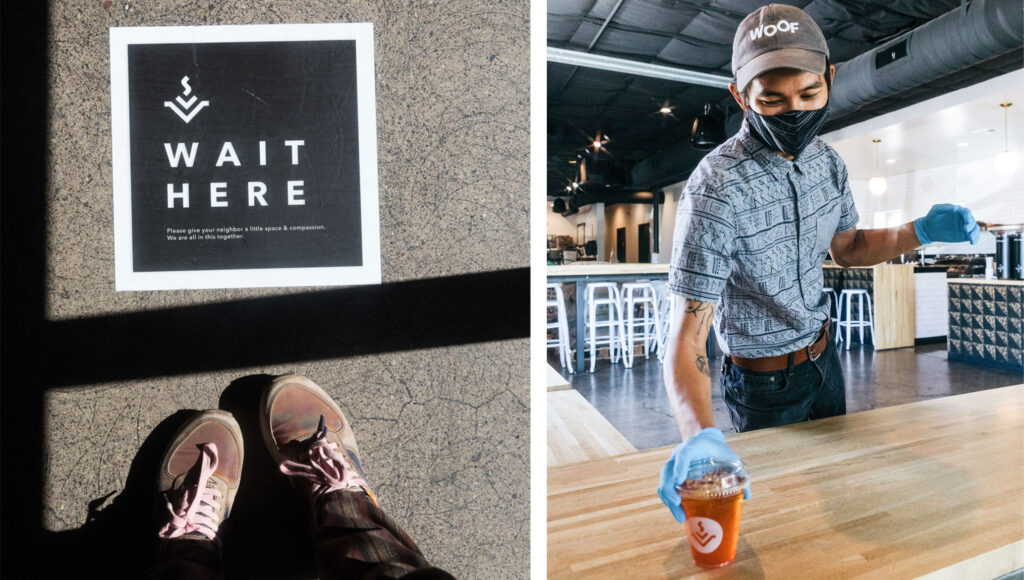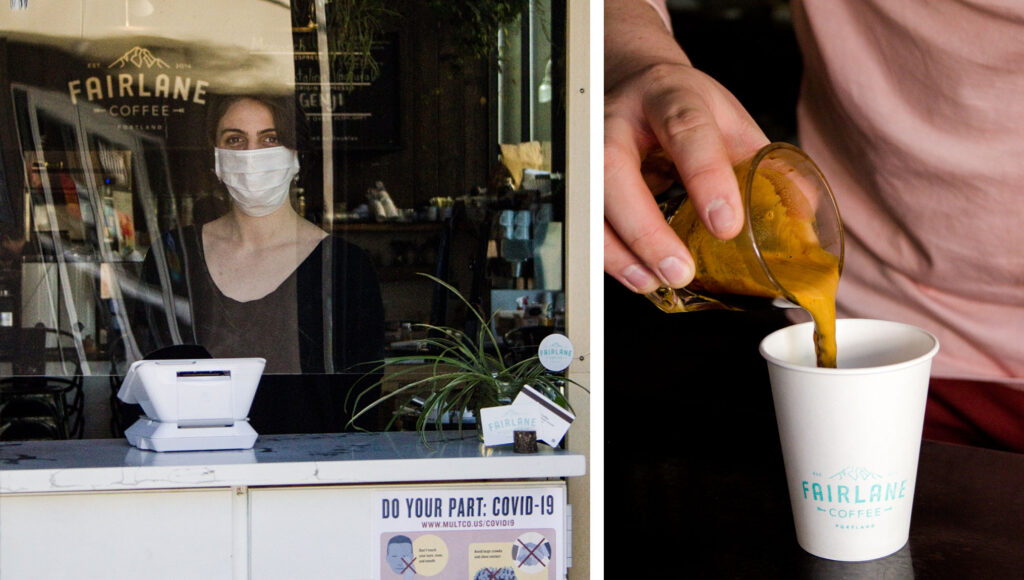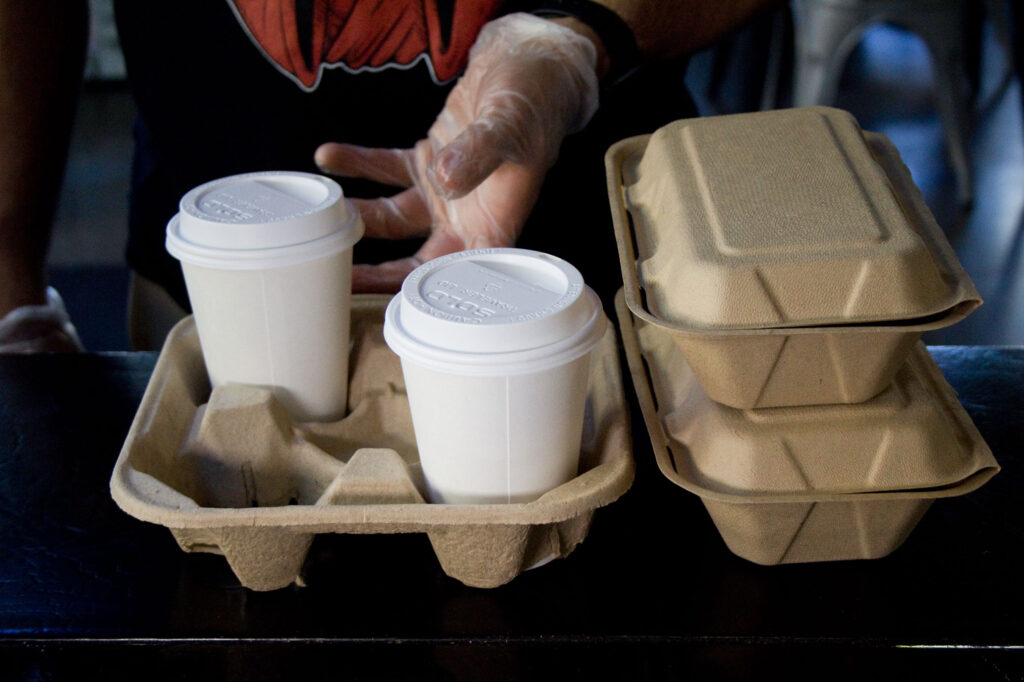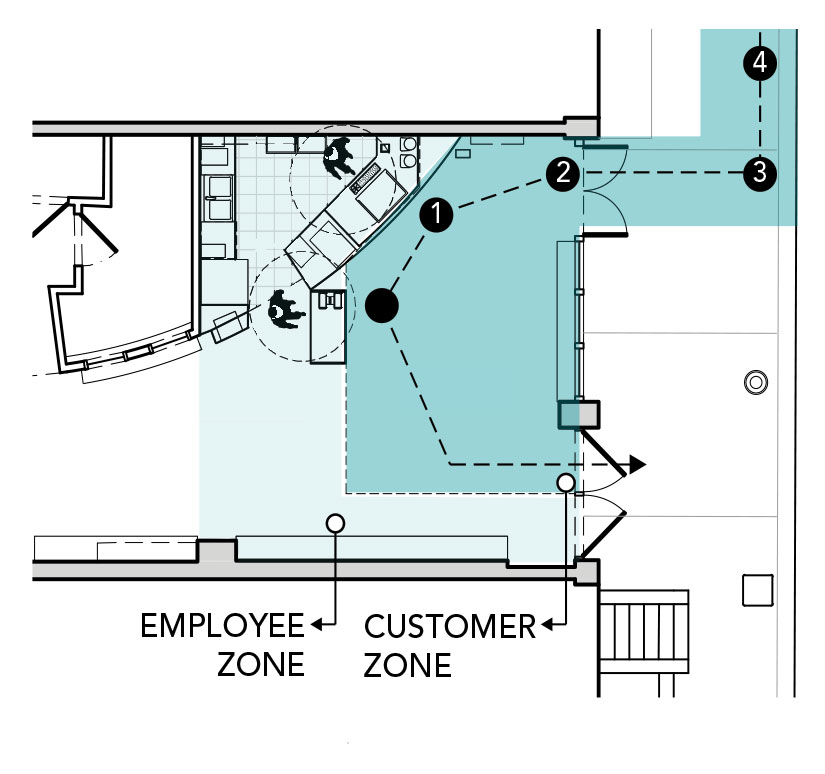FOUNDRY PROVISIONS in Indianapolis serves up coffee, breakfast, and lunch offerings with an outdoor patio welcoming guests who practice social distancing.
This piece was originally intended to provide inspiration for sprucing up your shop’s outdoor space for when the days get warmer and longer.
What we didn’t anticipate was an international pandemic that would turn the industry on its head in a matter of days.
Some cafés have stayed closed since the beginning.
Some adapted to the variety of health guidelines quickly.
Some applied for the Payment Protection Program before reopening their doors with limited hours.
While states are beginning to reopen and restrictions are easing up, many metropolitan areas are slowly doing the same, despite the growing number of cases continuing to be reported throughout the United States.
And as COVID-19 does not have a vaccine or cure as of this publication, café owners are addressing a possible second wave of cases even after the wave the country is currently in.
One thing is for certain: these cafés, along with many others, demonstrate one of our industry’s greatest strengths—that we can adapt even when it seems like there are no solid answers.
Limiting Contact Tips
Prefill condiments and add straws ahead of time for customers
Provide hand sanitizer
Allow restroom use by request
Ask employee to fill out credit card information during payments to limit use of credit card machine
Install plexiglass between employees and customers
Encourage masks and disposable glove use
Adapting Quickly
Cafés found ways to acclimate to closures and restrictions by reshaping their services almost overnight.
Foundry Provisions in Indianapolis, Indiana, wasn’t an exception.
Located a block away from an art center and not far from a high school, this café, with its locally sourced coffee and food menu, was the spot to grab a cup of coffee and chat with friends. As mid-March rolled around, Indiana initiated a stay-at-home order along with other states. Foundry closed about a week after nearby schools shut down.
“We paid attention to what [Governor Eric Holcomb] was asking us to do,” says manager Kimmie Burton. “He said unless you are an essential business, you need to cease operations. I perceived that we weren’t essential, but then I saw other shops were making a go of it….We found out we got a PPP loan early April and reopened with online ordering only and curbside pickup to where we would bring the drink to you.”
Burton says she loves the way the space is operating now after establishing an online ordering system with Square.
“Having to pivot due to COVID, and we didn’t have an online ordering system at the time before this all started, spurred us to get online ordering going,” she says. “Square made it easy to start one through them.”
In May, Square released a report in partnership with the Specialty Coffee Association analyzing payment trends during COVID-19. One finding showed combined sales for curbside and/or pickup orders increased 5,380% for surveyed businesses.
For Vesta Coffee Roasters in Las Vegas, online sales became its concentration after closing temporarily at the start of shutdowns. Not only does it sell its own coffee, but its full menu takeout is available on Postmates and Vesta Coffee Roasters’ app. Located in the city’s popular Arts District, Vesta began by sectioning off a third of the store to use less space, and custom printing vinyl for the floor to encourage social distancing.
“With Nevada, there really weren’t any concrete guidelines for us, we really had to go about it on our own,” says founder Jerad Jay. “Being at home for a bit, we thought about processes for our staff to create a plan to reopen that would work for us. I thought it would take a week to reopen for to-go and pickup, but it actually took about three days.”
Due to the desert’s climate, Vesta was already envisioning and prepping how to allow people to sit indoors to keep cool, says Jay.
“Right now, it feels like a ‘choose your own adventure’ service,” he says.
Vesta also created a QR code for people outside the store to scan and order a coffee if they are passing by.
“Not having interaction with the public is the hardest part,” says Jay. “I don’t think we will be where we were before this, but we know we can adapt and take this slow. We want to get people back in there, but how can we do that safely?”
Safety First
Even though prolonged person-to-person interactions and group meetups are down to a minimum, the breadth of customers that usually attend each shop are growing.
Fairlane in Portland, Oregon’s Sellwood neighborhood is currently open for to-go, delivery, and pickup.
Its owners, husband-and-wife team Alexander and Alex Assaf, designed a strategy that considered the security and health needs of their employees and customers simultaneously as they saw an increase of customers and sales.
Alex Assaf is a registered nurse by trade; her time in the medical field inspired and informed her to implement a plan to limit ways customers and employees can interact.
“It was really easy to see where there are potential transmission points, like at our register or handling cash back and forth and staff touching their face,” she says. “With my RN background, I was able to reinforce with folks before guidelines came out. The Centers for Disease Control and Prevention is a great resource, but it is also about taking a step back and thinking like a health professional, ‘Where is someone touching something that can have contact with someone else’s face, eyes, and mouth?’”
Fairlane held three emergency meetings with its staff addressing COVID-19 measures as Portland went into shutdown, and came out with several action items to create a safe space, says Alexander.
“We immediately sealed off entry and exit to our facility,” he says. Fairlane’s entrance is now a walk-up window, so only staff can be inside the space and customers order on the other side of plexiglass. “As folks queue up for coffee, we are fortunate to have patio space with our layout, but our number one concern was rolling our cart up to the front door so people could see us if they were walking up and down the sidewalks. We have been able to pick up new customers and our staff can engage with them in a friendly, polite way.”
The Assafs set up a guide for Fairlane employees to refer to regarding sanitization guidelines and social distancing.
“Every time someone touches anything, we wipe it down,” says Alexander. “We were concerned about not being able to provide dining service, but ultimately the Fairlane experience is one of being safe. One of feeling that you can come and have a regular routine with us and not have your health at risk as a result.
“We found that, at the peak, we had about a fifty percent-increase in our customer base, and that may be because we were one of few shops open, but now we still have an increase of people coming here,” he adds. “We see that in Portland, there will be some easing and reopening, but we still do not feel comfortable inviting people back in the shop. It is too much of a safety risk for our staff.”
Starting out with a bar cart converted into a pay station, Fairlane made a more permanent solution with plywood and plexiglass, so everything from pastries to retail is showcased at the front. A place for customers to sit outside in the near future is possible, but Fairlane wants to ease into changing its set-up.
“We have been able to adapt quickly, and we are really fortunate,” says Alexander. “At the end of the day, it is about keeping people safe and our baristas employed.”
What Coffee Shops are Open in Your Area?
Check out CoffeeisOpen
Designing for a Second Wave
Jane Kim is a registered architect and LEED Accredited Professional. She owns a small practice, Jane Kim Design, in New York City with two other employees. They have renovated about 10 coffee shops, mainly in Manhattan and Brooklyn.
Kim recently released online and on social media “Reopening Specialty Coffee: New Practices after COVID-19,” a guide she created to spark a conversation on how coffee shops, both in New York and nationally, can reshape their spaces with what is called a “minimal contact strategy.”
“I was trying to find a way to give back to the community,” says Kim. “I reached out to former clients of mine…just to see if they wanted help and think about how they would reopen their shops. From my research, I realized there wasn’t much information from the government. It didn’t seem like there were a lot of shop owners talking about how they were handling protecting their employees and making safe spaces for their customers.”
Kim read about how the owners of Wrecking Ball Coffee Roasters in San Francisco, Nick Cho and Trish Rothgeb, modified Wrecking Ball as COVID-19 shut down the city. Cho went on to share his limited opening plan in an article he wrote for Medium, an online publishing platform, stating that almost overnight, Wrecking Ball turned into a walkup window café.
Cho and Rothgeb’s cafés limited contact between server and customer by customizing drinks ahead of time, with the server prefilling drinks with sugar, milk, and/or a straw upon customers’ request. Customers were encouraged to pay with cards instead of cash, with Wrecking Ball supplying Post-it Note-sized wax paper for customers to pick up and use to cover the POS system.
Kim’s design shows a graphic on how it can look like at a business’s door opening, similar to Wrecking Ball.
“We thought, ‘How could we help add to this conversation?’ and that was to create a graphic way of understanding the different techniques of protecting people,” says Kim. “I wanted to get all this information in one place that people could find.”
The design is available to view for free online, and depicts two strategies: “door service” and “limited service.”
Jane Kim’s Guide to Door Service Design
Spatial Separation: Use plexiglass barriers, reduce contact points by prepping ahead
Sanitizing: Regularly clean areas that interact with customers
Signage: Create clear, large messages for customer ease
Sidewalk Traffic: Look into city’s policies on sidewalk space, consider social distancing seating options
Find Jane Kim’s design plan here.
Door service expresses minimal contact between the server and customer, including reducing air flow with a plexiglass barrier and limited opportunities for customers to touch items in the shop.
“We talk about [plexiglass] because you can have the clearest communication between people and it is the easiest to keep clean,” says Kim. “You can block the whole door opening so there is no air passing through except a gap down below for pass thru. It also creates visual connection and space.
“I think in New York, people are being extra careful just because of how bad the infections have been here,” she adds. “So it seems like most shops want to keep customers outside of the summer, and use a plexiglass barrier at the door, with employees inside and customers outside. Nothing crosses that but the drink. We try to follow what people understand are the best practices and separate the air from people to prevent infection from spreading.”
The second strategy, limited service, outlines how cafés can return to operate within their spaces. In the design, customers would be able to be inside the store three at a time, but there would be a clear separation between the “employee zone” and the “customer zone.” The employee zone would be modified for six feet of distancing between servers, or encouraging on server on per shift.
“We’re trying to work with coffee shop owners to think about a phase two,” says Kim. “Here, people could still come into shops and still be safe with social distancing and thinking about spacing out workers. This also would prevent overlaps of circulation paths. With the colder weather, there needs to be a second step of bringing people into the shops more…This [design] is going to continue to evolve.”
Click here for disinfecting tips from the CDC
Stay—For A While
While increased to-go orders are taking off for many shops, semi-permanent outdoor spaces promoting safe social distancing are also popping up as the alternative to allowing guests indoors.
Foundry’s patio setup includes tables spaced six feet apart and limits the amount of people that can sit at each one. Indianapolis made special arrangements for restaurants that didn’t originally have patios to bump out their spaces into sidewalks, says Burton.
But as everchanging guidelines say to limit the number of customers, Burton says one concern is how businesses can sustain operating at a percentage of their usual capacities.
“We are asking, ‘Is this feasible?’ she says. “We’ve been doing enough online and with carry out, that the patio and outdoor space is just kind of offering a place to sit down. For other places, they’re having to decide if it is worth it.”
Wiping down tables in between guests’ visits, placing umbrellas on the table, and giving access to hand sanitizer outside is helping Foundry stay safe while offering more, says Burton.
While being in the restaurant industry helps her think in terms of safety and sanitization, says Burton, shebelieves COVID-19 is the time to revisit guidelines and protocols around greater public health.
“I think people are feeling similarly [in the business community],” she says. “There is a lot of information being thrown at us as business owners, and it can feel daunting to feel like you can screw up. You are putting someone’s life potentially at risk if you don’t do something right. But it is also a kick in the pants to think safer and smarter, and encourage that behavior in your customers.”



